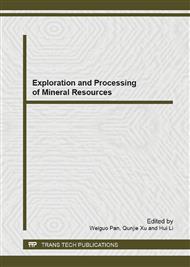[1]
Sihua Cui, Fansheng Ban, Guangjie Yuan. Natural gas industry, 2011, 31 (4) : 72-75. In Chinese.
Google Scholar
[2]
Zhao H,Givens N B,Curtis B. AAPG bulletin, 2007,91(4): 535-549.
Google Scholar
[3]
Baroid. 1994. Oil Mud Technology Manual. Baroid Drilling Fluids. Houston,TX,67 pp.
Google Scholar
[4]
Caenn R;Chillingar G V. Journal of Petroleum Science and Engineering,1996,14: 221-230.
Google Scholar
[5]
Tao He, Maosen Li, Lanping Yang, et al. Drilling fluids and completion fluids, 2012, 29 (3) : 1-5. In Chinese.
Google Scholar
[6]
Chenevert M E. Journal of Petroleum technology,1970,22(10): 1309-1316.
Google Scholar
[7]
Bennett R B. Journal of petroleum technology, 1984, 36(6): 975-981.
Google Scholar
[8]
James R W,Helland B. The Greater Ekofisk Area: Addressing Drilling Fluid Challenges With Environmental Justifications[C]/European Petroleum Conference. (1992).
DOI: 10.2118/25044-ms
Google Scholar
[9]
Information on http: /wenku. baidu. com/view/1f70adf0941ea76e58fa0494. html.
Google Scholar
[10]
JinYu Xiao, Lanping Yang, Maosheng Li, et al. Drilling fluids and completion fluids, 2011, 28 (6) : 21-23. In Chinese.
Google Scholar
[11]
Xiao Niu, Qingyun Shen, Peizhi Yu, et al. Drilling fluids and completion fluids, 2011, 28 (001) : 81-83. In Chinese.
Google Scholar
[12]
Luocheng Fan, Xingfu Yang, Hua Wang, et al. Petroleum Drilling Techniques, 2012, 40 (4) : 38-42. In Chinese.
Google Scholar
[13]
Jinfeng Xu, bin Liu, Qiang Lan, et al. Western exploration engineering, 2007, 19 (11) : 77-80. In Chinese.
Google Scholar
[14]
Clark R K,Scheuerman R F,Rath H,et al. Journal of Petroleum Technology,1976,28(6): 719-727.
Google Scholar
[15]
Hale A H,Mody F K. Partially hydrolyzed polyacrylamide (PHPA) mud systems for Gulf of Mexico deepwater prospects[C]/SPE International Symposium on Oilfield Chemistry. (1993).
DOI: 10.2118/25180-ms
Google Scholar
[16]
Ling Liu, Jinping Gao, Dongrong Guo. Petroleum Drilling Techniques, 1999, 27 (1) : 49-51. In Chinese.
Google Scholar
[17]
Jiankang Guo, Jienian Yan, Kuicai Wang, et al. Drilling fluids and completion fluids, 2005, 22 (1) : 14 - 18. In Chinese.
Google Scholar
[18]
Van Oort E,Ripley D,Ward I,et al. Silicate-based drilling fluids: competent,cost-effectiveand benign solutions to wellbore stability problems[C]/IADC/SPE drilling conference. 1996: 189-204.
DOI: 10.2118/35059-ms
Google Scholar
[19]
Riley M, Young S, Stamatakis E, et al. Wellbore Stability in Unconventional Shales-The Design of a Nano-Particle Fluid[C]/SPE Oil and Gas India Conference and Exhibition. (2012).
Google Scholar
[20]
Mody F.K. and Hale A.H.: A Borehole Stability Model To Couple the Mechanics and Chemistry of Drilling Fluid Shale Interaction,, JPT (Nov. 1993) 1093.
DOI: 10.2118/25728-pa
Google Scholar
[21]
Deville J,Fritz B,Jarrett M. SPE Drilling & Completion,2011,26(4): 484-491.
Google Scholar


